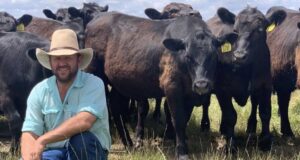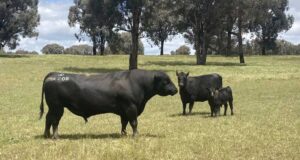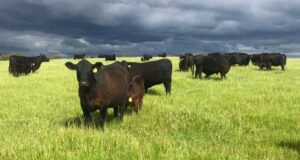Increasing selection capability with Angus HeiferSELECT


Dane and Alison Skinner run a high-performance Angus breeding operation in Big Springs, NSW. Their strategic approach, highlighted by their use of Angus HeiferSELECT, underscores their commitment to advancing cattle genetics and optimising herd performance.
Dane and Alison Skinner have transformed their 664-hectare property, Lawn Hill at Big Springs, into a leading example of innovative Angus breeding. Since purchasing the property about a decade ago, they have fully transitioned from cropping to a dedicated cattle operation, focusing on a self-replacing Angus herd of 330 breeders. Their strategic use of genomic tools, including Angus HeiferSELECT and more recently, Angus SteerSELECT, has significantly enhanced their breeding program.
 “I grew up on a mixed farm on the edge of the Hay Plains at Gunbar and always had a love of cattle,” says Dane Skinner. “We bought the farm where we are now about 10 years ago. When we did this, we were cropping and starting to build our cattle numbers, and about 7-8 years ago we went all cattle and haven’t looked back.”
“I grew up on a mixed farm on the edge of the Hay Plains at Gunbar and always had a love of cattle,” says Dane Skinner. “We bought the farm where we are now about 10 years ago. When we did this, we were cropping and starting to build our cattle numbers, and about 7-8 years ago we went all cattle and haven’t looked back.”
Dane and Alison produce steers for the high-end carcass market, aiming for mid- to long-fed programs with high marbling and MSA grading carcasses, as well as marketing surplus females based on their genetic merit.
“We run a self-replacing breeding herd that revolves around having high carcass merit animals, females that have the ability to get in calf in a 6-week joining, calve unassisted and get back in calf early. When mature we want a moderate mature cow weight,” says Dane.
“We calve one third in the Autumn and two thirds in the Spring which allows us to get more out of our bulls. Every Female in the Spring mob is AI’d and for the last 4 years every heifer has been genetically tested,” adds Dane.
Heifers are joined at 14 months of age for a 9-week joining period. Following the joining period, females are pregnancy tested and only those within the 6-week window are retained within the herd. The Skinners have an average conception rate in the mid 90 percentile.
“We have been using AI since we started building our cow herd. Every female in the Spring program is AI’d at least once, some twice, depending on genomic data. The outcomes of this have been that we are able to have a tight calving period with the bulk of our females calving early and closely. The genetic gain has been impressive with the ability to use some very high-quality bulls for AI sires,” explains Dane.
The Role of HeiferSELECT
The Skinners have been using HeiferSELECT for four years, integrating it as a core component of their breeding strategy. The genomic data enables them to make more informed decisions about which heifers are kept for breeding, which are AI’d, and which are culled.
“We have been using Heifer Select for 4 years now and have been part of the validation process for Steer Select for the last 2 years,” explains Dane. “We started with HeiferSELECT to use as another selection tool for us. Through many years of AI, we were at a stage where our oldest cows were 6 years old, so we weren’t culling for age. We wanted to make sure we knew exactly which animals we were keeping and which to move on.”
 Every heifer born on the property is now tested with HeiferSELECT.
Every heifer born on the property is now tested with HeiferSELECT.
“The benefit of implementing HeiferSELECT has been knowing the genetic potential of our heifers from a very young age and then being able to make decisions about their future early and with the steers, it allows us to show the potential of the steers when it comes to marketing,” explains Dane.
“With both programs the biggest benefit is being able to see the direction our herd is going and then make bull selections based on this. Now that we have a few years of data we are able to see the change year on year,” adds Dane.
By using HeiferSELECT, the Skinners have improved the genetic quality of their herd. The tool’s detailed predictions help them select heifers with the best potential for fertility, growth, and carcass traits, leading to a more consistent and high-performing herd.
“We have always culled hard on temperament and structure and don’t have many issues with these now. Anything that is empty, late or doesn’t wean a calf is also culled. With Heifer Select we are able to identify the tail of our herd and remove them also which in turn lifts our whole herd average,” says Dane.
When selecting sires for the herd, Dane and Alison aim to keep MCW close to 400-day weight, emphasizes the importance of high IMF EBV figures, slightly positive fats, moderate birth weights and good growth while maintaining calving ease and gestation length. Dane has found that his HeiferSELECT results are reflective of his sire selections.
“Our sire selections have corresponded greatly with our Heifer select results. We are seeing trends moving in the direction we want them to. We try to have our bulls on farm have similar data sets to the AI sire we use so we take the whole herd in that direction. We can see great improvement in our carcass traits as well as improvement across the board,” says Dane.
Looking ahead, Dane and Alison aim to continue leveraging HeiferSELECT to further refine their breeding program and utilise SteerSELECT to market their steer progeny based on genetic merit. They seek to continue to enhance the genetic consistency and performance of their herd, aiming for tighter lines of cattle that consistently perform at the highest levels.
“We want to be turning off tight, consistent lines of animals,” Dane concludes.
Carcass Feedback Trials
Dane and Alison have been participating in the Teys Beef Spectacular Feedback Trial for about 8 years and more recently, also entering the Beef 2024 National Beef Carcass Competition.
In 2024, Dane and Alison won Reserve Champion Pen of 5 steers, Riverine Premium beef champion pen and placed 1st for eating quality. As well as being the National winner of the grain fed heavy trade steer or heifer (280-360kg) category as part of the Beef 2024 National Beef Carcass Competition.
 “The benefits of doing the trials are that you see how the final product turned out. The data we receive back in these trials goes into great depth and gives you a really good breakdown of the animal,” says Dane.
“The benefits of doing the trials are that you see how the final product turned out. The data we receive back in these trials goes into great depth and gives you a really good breakdown of the animal,” says Dane.
“We use the feedback to make sure we are producing the type of animals we want. We have won several awards throughout both competitions and are also able to use these results to
help with marketing. It just proves that we are producing the types of animals that we are aiming for,” adds Dane.
Conclusion
Dane and Alison Skinner’s use of HeiferSELECT illustrates the transformative impact of genomic technology in modern cattle breeding. By integrating HeiferSELECT into their operations, they have achieved significant genetic improvements, enhanced their breeding decisions, and effectively managed their herd to meet high performance and quality standards, as showcased by their recent carcass feedback trial results.
Hanlie Jansen, Extension Officer